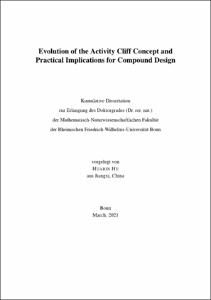Evolution of the Activity Cliff Concept and Practical Implications for Compound Design

Evolution of the Activity Cliff Concept and Practical Implications for Compound Design

| dc.contributor.advisor | Bajorath, Jürgen | |
| dc.contributor.author | Hu, Huabin | |
| dc.date.accessioned | 2021-07-22T08:40:05Z | |
| dc.date.available | 2021-07-22T08:40:05Z | |
| dc.date.issued | 22.07.2021 | |
| dc.identifier.uri | https://hdl.handle.net/20.500.11811/9232 | |
| dc.description.abstract | Entering the “big data” era, a number of different research areas have witnessed an enormous increase in data at an exponential rate. For drug discovery, various publicly available protein structure and compound bioactivity databases enable data driven drug identification, which are further facilitated by advanced computational methods. The principle objective of structure-activity relationship (SAR) analysis is to identify structural determinants that are responsible for biological activities of compounds or other drug-relevant properties. Central to SAR analysis is the notion of molecular similarity, which can be assessed based on different principles and molecular representations. As a primary focal point of SAR analysis, activity cliffs (ACs) are receiving increased attention. By definition, ACs are formed by pairs of structurally similar compounds with large differences in potency, and thus encapsulating the notion of minor chemical modifications having large biological effects. This thesis concentrates on large-scale AC analysis using different structural similarity and potency difference criteria, and corresponding practical implications for compound optimization in medicinal chemistry. First, AC networks, a central data structure for cliff-associated SAR analysis, was simplified yielding immediate access to SAR information. Then, a variety of molecular similarity approaches were developed, which were utilized in AC analysis to derive SAR determinants from different structural perspectives. Moreover, activity class-dependent potency difference criteria were derived by taking potency value distributions of target-based compound activity classes into account. Analyzing these similarity and potency difference criteria, this thesis represents a further evolution of the AC concept: from single- to multi-site ACs and from general to activity class-dependent AC definitions. Going beyond molecular similarity and potency difference thresholds in AC assessment, the inclusion of privileged substructures, structural isomers and single-site analogs further extended the AC concept for medicinal chemistry. | en |
| dc.language.iso | eng | |
| dc.rights | In Copyright | |
| dc.rights.uri | http://rightsstatements.org/vocab/InC/1.0/ | |
| dc.subject.ddc | 004 Informatik | |
| dc.subject.ddc | 540 Chemie | |
| dc.subject.ddc | 570 Biowissenschaften, Biologie | |
| dc.subject.ddc | 610 Medizin, Gesundheit | |
| dc.title | Evolution of the Activity Cliff Concept and Practical Implications for Compound Design | |
| dc.type | Dissertation oder Habilitation | |
| dc.publisher.name | Universitäts- und Landesbibliothek Bonn | |
| dc.publisher.location | Bonn | |
| dc.rights.accessRights | openAccess | |
| dc.identifier.urn | https://nbn-resolving.org/urn:nbn:de:hbz:5-63174 | |
| ulbbn.pubtype | Erstveröffentlichung | |
| ulbbn.birthname | 015237620144 | |
| ulbbnediss.affiliation.name | Rheinische Friedrich-Wilhelms-Universität Bonn | |
| ulbbnediss.affiliation.location | Bonn | |
| ulbbnediss.thesis.level | Dissertation | |
| ulbbnediss.dissID | 6317 | |
| ulbbnediss.date.accepted | 12.07.2021 | |
| ulbbnediss.institute | Zentrale wissenschaftliche Einrichtungen : Bonn-Aachen International Center for Information Technology (b-it) | |
| ulbbnediss.fakultaet | Mathematisch-Naturwissenschaftliche Fakultät | |
| dc.contributor.coReferee | Gütschow, Michael | |
| ulbbnediss.contributor.gnd | 124203563X |
Files in this item
This item appears in the following Collection(s)
-
E-Dissertationen (4442)




